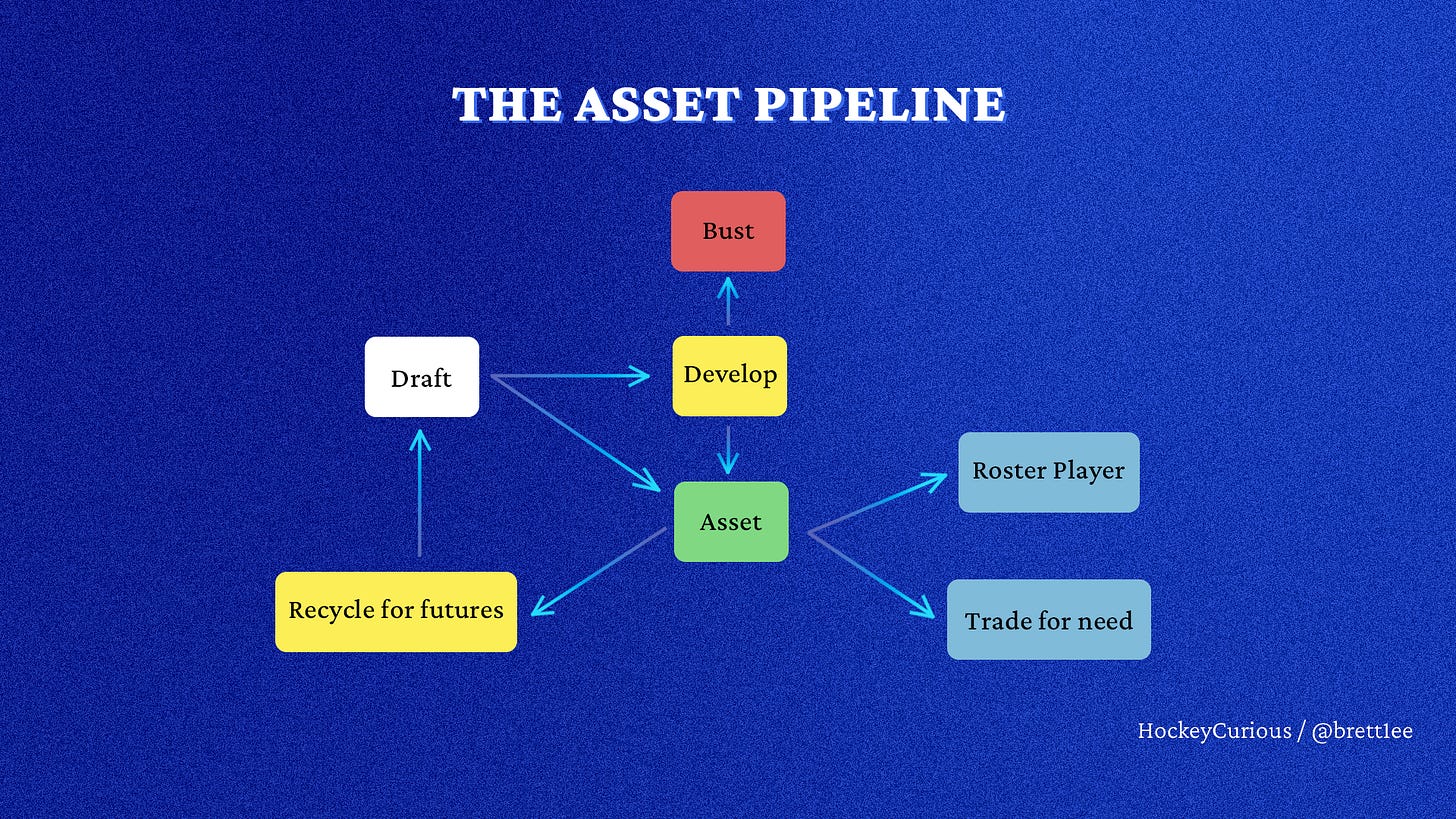In the last eight seasons, no team has seen as much success as the Tampa Bay Lightning. During this time they’ve had the highest points percentage in the league, won two Stanley Cups, made four Stanley Cup Finals, and collected two Presidents Trophies.
Here’s how they did it.
When Steve Yzerman took over the Lightning in 2010, he inherited Steven Stamkos and Victor Hedman, two franchise-defining talents. But how the Lightning built a supporting cast through their robust asset pipeline is what separates them ahead of other teams with top-end talent like the Edmonton Oilers with Connor McDavid and Leon Draisaitl.
Further reading: The Asset Pipeline
Lightning 1.0
In the early years of Yzerman’s tenure, it seemed his scouting and development teams could do no wrong.
The Hall-of-Famer allowed his team to draft without prejudice which led to the legendary draft class of 2011 that saw the Lightning select Vladislav Namestnikov, Nikita Kucherov, and Nikita Nesterov. Director of scouting Al Murray deserves immense credit for unearthing late-round gems such as Ondrej Palat in the 7th round in that franchise-defining 2011 draft. They also mined value by signing undrafted college and junior hockey prospects. They crucially found Tyler Johnson in 2011 out of the WHL.
But identifying talent is only one half of the puzzle. Once assimilated into the organization, the onus is on the player to work hard to reach their potential. And this is where the NHL team must invest heavily into building a strong development program internally. The Lightning did just that, including bringing Barb Underhill into the organization as a power skating coach, famous around the league for fixing Brayden Point’s stride, converting his skating from a weakness into a strength.
Tampa’s American Hockey League program was a behemoth in the early 2010s winning a Division title and going all the way to the Calder Cup Finals with key prospects like Palat and Johnson leading the way. This was also the breeding ground for future head coach Jon Cooper.
By 2015, 14 players on Tampa’s roster had only known the Lightning in their professional careers: Steven Stamkos, Victor Hedman, Nikita Kucherov, Andrei Vasilevsky, Tyler Johnson, Ondrej Palat, Alex Killorn, Jonathan Drouin, Cedric Paquette, Vladislav Namestnikov, Brett Connolly, J.T. Brown, Nikita Nesterov, and Andrej Sustr.
10 of them were draft picks, 4 college or junior signings, and 12 of them made their way through the AHL team.
This was a team that led the NHL in scoring and collected 50 wins but ultimately fell short of the Chicago Blackhawks. As good as it was, it wasn’t good enough.
Lightning 2.0
Drafting and developing get the most spotlight when discussing the Lightning’s dominance over the past decade but what often gets forgotten is how they retooled using draft picks and prospects.
The Lightning crucially leveraged its asset pipeline in order to retool and build a supporting cast around its first wave of talent.
The first step was to acquire a surplus of draft picks which at first, feels contrary to the goal of a contender. Why acquire future assets when in win-now mode?
In 2015 and 2016, the Lightning picked 19 times in the draft instead of the standard 14 that every team begins with. They fully utilized the asset pipeline as they recycled past drafted assets into futures:
Brett Connoly (drafted in 2010) to the Bruins for 2015 2nd and 2016 2nd
Anthony Deangelo (drafted in 2014) to the Coyotes for 2016 2nd
Those 19 prospects entered the pipeline with the rest of their assets and developed into key future contributors like:
Brayden Point (2014 3rd)
Anthony Cirelli (2015 3rd)
Mathieu Joseph (2015 4th)
Ross Colton (2016 4th)
But, like the asset pipeline outlines, becoming a roster player is not the only outcome for an asset. The Lightning monetized their war chest of picks and prospects to acquire the finishing touches to their team.
Jonathan Drouin (2013 1st) and 2018 6th to the Canadiens for Mikhail Sergachev and 2018 2nd
Vladislav Namestnikov (2011 1st), Brett Howden (2016 1st), Libor Hajek (2016 2nd), 2018 1st, and 2019 2nd to the Rangers for Ryan McDonagh and J.T. Miller
Slater Koekkoek (2012 1st), and 2019 3rd to the Blackhawks for Jan Rutta and 2019 7th
Nolan Foote (2019 1st) and 2020 1st to the Devils for Blake Coleman
Taylor Raddysh (2016 2nd), Boris Katchouk (2016 2nd), 2023 1st, and 2024 1st to the Blackhawks for Brandon Hagel, 2022 4th, and 2024 4th
Mathieu Joseph (2015 4th) and 2024 4th to the Senators for Nicholas Paul
The retool wasn’t instant. The Lightning didn’t immediately acquire all the pieces that made them the behemoth they have been for the past three seasons. Rather they acquired picks and prospects, recognizing that those assets are the vehicle to acquire the right players when the opportunity arose.
The Lightning are still keeping its asset pipeline churning as best as possible. They’ve gotten value back for expiring assets as best as they can:
Barclay Goodroow to the Rangers for 2022 7th
Mitchell Stephens to the Red Wings for 2022 6th
Alexander Volkov to the Ducks for Antoine Morand and 2023 7th
Adam Erne to the Red Wings for 2020 4th
Long live the pipeline.




